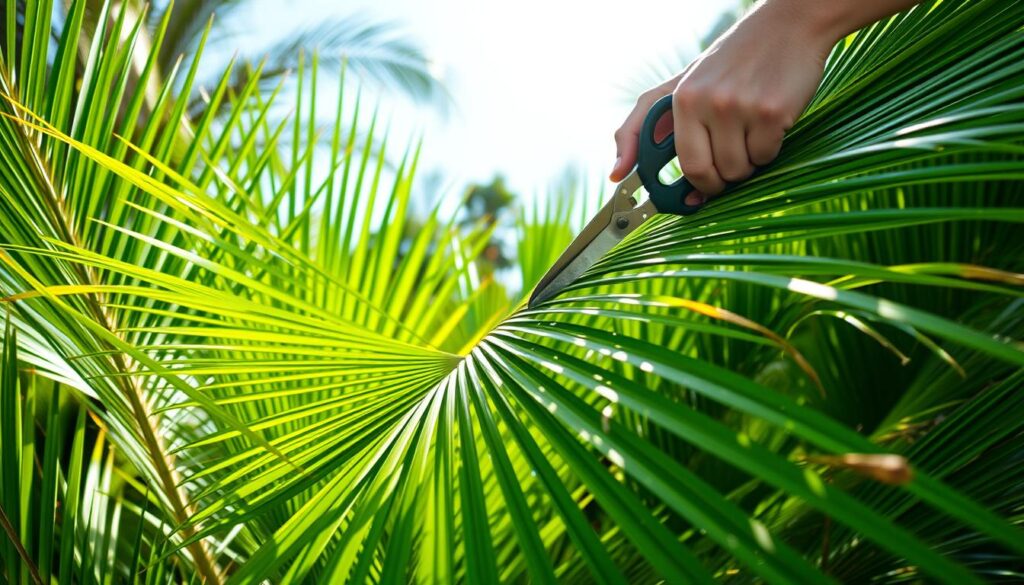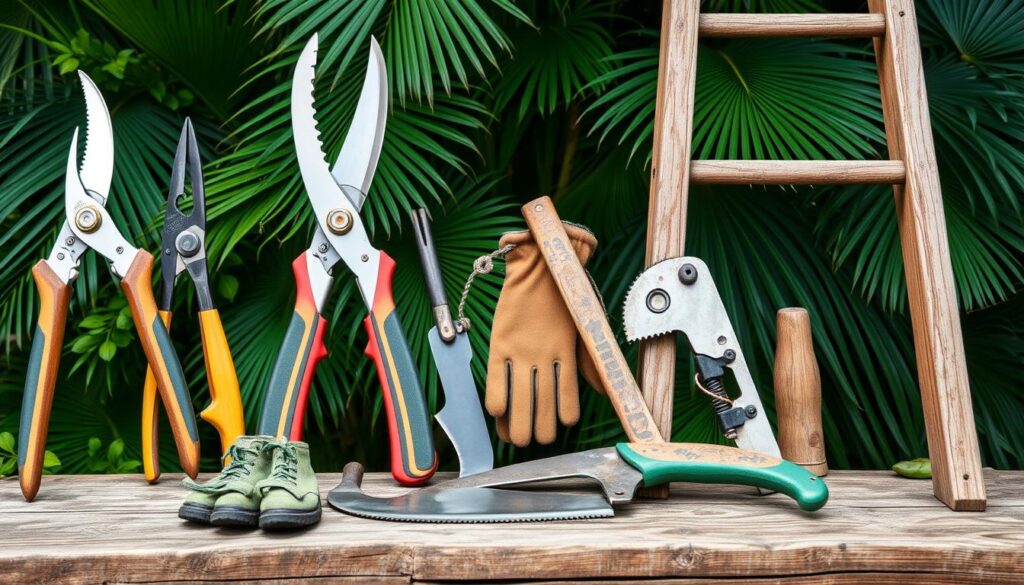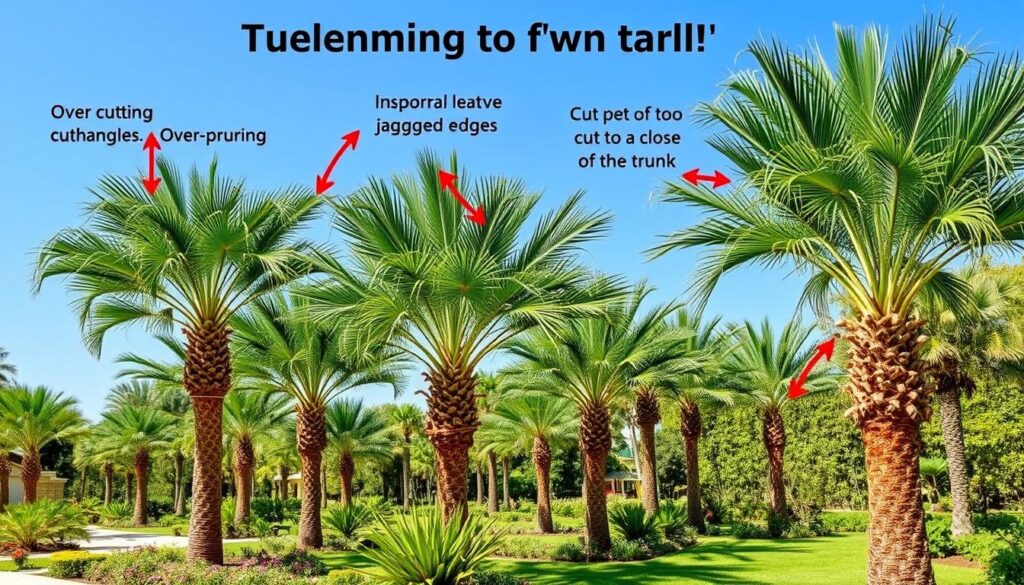Knowing how to trim a fan palm is key for its health and looks. With the right methods, you can make your fan palm thrive. To start, it’s important to know about fan palm pruning tips and follow a step-by-step guide. For more on pruning, check out fan palm pruning tips to begin.
When pruning, remove no more than 25% of the fronds for a balanced look. Prune your Mexican Fan Palm once a year, best in spring. Pruning works best when the palm is growing, which is in spring and early summer.
By using the right pruning tips and tools, your fan palm will stay healthy and look great. Learning to trim a fan palm takes care and the right techniques. That’s why we’ve created this detailed guide to help you start your fan palm trimming journey.
Table of Contents
Key Takeaways
- Trimming a fan palm is essential for its health and appearance.
- Optimal foliage removal should not exceed 25% of the total fronds during pruning.
- The ideal pruning frequency for Mexican Fan Palms is once a year, specific to the spring season.
- Pruning is most effective during the palm’s active growth phase.
- Learning how to trim a fan palm requires attention to detail and the right techniques.
- A step by step fan palm trimming guide can help you achieve a thriving and elegant fan palm.
- Fan palm pruning tips are vital for keeping your fan palm healthy and looking good.
Introduction to Fan Palms
Fan palm trees are a favorite for landscaping because of their elegant shape. They belong to the monocot family, with a single growing point at the top. To keep them looking good, regular pruning is needed.
Pruning involves removing dead fronds, cutting back overgrown ones, and shaping the palm. This makes the palm look better.
There are many types of fan palms, each with its own look and growth pattern. Taking good care of them is key to their health. This means giving them enough water, nutrients, and protecting them from pests and diseases.
- Pruning dead or dying fronds to prevent damage and promote healthy growth
- Providing adequate water and nutrients to support growth and development
- Protecting the palm from pests and diseases to prevent damage and infection
Knowing what fan palm trees need and caring for them properly brings many benefits. Their elegant shape and easy care make them perfect for landscaping and gardening.
When to Trim a Fan Palm
Trimming a fan palm is key to its care. Knowing when to trim a fan palm is vital for its health and look. The best time is in spring when it’s growing fast. This is when you can remove dead fronds, cut back long ones, and shape it for looks.
A fan palm trimming schedule should match its growth cycle and signs of being too big. Look for brown or yellow fronds, long fronds, or no new growth. Regular checks help find the best trimming time.
When planning the fan palm trimming schedule, consider its type, age, and how fast it grows. Some, like the Mexican fan palm, grow 3 feet a year and need more trimming. The palm’s spot and weather also affect its growth and trimming needs.

- Brown or yellow fronds
- Long fronds
- No new growth
By keeping these points in mind and checking the palm often, you can make a fan palm trimming schedule that fits its needs. This keeps it healthy and looking great.
Tools Needed for Trimming
Trimming a fan palm needs the right tools. These tools are key for clean cuts that keep your palm healthy. Fan palm trimming tools include hand pruners, loppers, and pole saws. They help reach high fronds without climbing.
A pruning saw is great for thicker branches. It’s important to pick a sharp saw to avoid damage. A pole saw is also vital for safety when trimming high fronds.
Don’t forget safety gear like gloves, safety glasses, and a first aid kit. They protect you from injuries. With the right tools and safety gear, trimming your fan palm is safe and effective.

- Hand pruners for cutting smaller fronds
- Loppers for larger or thicker fronds
- Pole saw for reaching high fronds
- Pruning saw for handling thicker branches
| Tool | Description |
|---|---|
| Hand pruners | Ideal for cutting smaller fronds and removing dead leaves with precise cuts |
| Loppers | Recommended for larger or thicker fronds due to their long handles that provide extra leverage |
| Pole saw | Essential for reaching high fronds on tall palm trees without needing to climb |
Step-by-Step Trimming Process
When trimming fan palms, it’s key to follow a step-by-step guide. This ensures the palm’s health and safety. Start by clearing the area and laying down a tarp to catch debris.
Then, remove dead or dying fronds by cutting them at the base. This step is vital in step by step fan palm trimming. It stops disease and pest spread. Use a pruning saw or loppers for clean cuts, avoiding damage to the trunk or other fronds.
Once dead fronds are removed, cut back overgrown ones. Use pruning saws or loppers for clean cuts. This shapes the palm and enhances its look. For more tips on how to cut a fan palm, talk to a professional arborist or gardening expert.
Properly disposing of cut fronds is also key. It prevents disease and pest spread. Bag and throw away cut fronds or compost them for nutrient-rich soil.
By following these steps and using the right fan palm pruning techniques, your palm tree will stay healthy and vibrant. Always prioritize safety and take precautions when trimming your palm tree.
Common Mistakes to Avoid
Trimming a fan palm can be tricky. One big mistake is over-trimming a fan palm. This can stress the palm and make it more likely to get fan palm disease. Cutting too much can weaken the tree, making it more vulnerable to disease.
Another error is ignoring signs of disease or pests. Regular checks can help catch problems early. This can stop damage and keep your palm healthy. Some common mistakes to avoid include:
- Over-trimming, which can lead to disease and stress
- Under-trimming, which can lead to a lack of new growth and decline in the palm’s overall health
- Ignoring disease, which can spread quickly and cause significant damage to the palm

To avoid these mistakes, knowing common mistakes in fan palm trimming is key. Take a careful and informed approach to trimming. This way, you can prevent fan palm disease and keep your palm healthy and strong.
Maintenance After Trimming
After trimming, it’s key to keep your fan palm healthy. Make sure to water a fan palm often, but don’t let the soil get too wet. Also, use a balanced fertilizer that’s rich in nitrogen to help it grow well.
Keeping your fan palm in top shape means paying attention to its water and food needs. Here are some important tips for fan palm maintenance:
- Water the palm regularly, but avoid overwatering, which can lead to root rot and other problems.
- Fertilize the palm with a balanced fertilizer during the growing season to promote healthy growth and development.
- Inspect the palm regularly for pests and diseases, and take action promptly if you notice any issues.
By following these tips and giving your palm the right care, it will bounce back from trimming and stay healthy. Always water a fan palm carefully and fertilize a fan palm regularly to support its growth.
| Maintenance Task | Frequency | Importance |
|---|---|---|
| Watering | Regularly | High |
| Fertilizing | During growing season | Medium |
| Inspecting for pests and diseases | Regularly | High |
Troubleshooting Trimmed Fan Palms
Trimming a fan palm can lead to some issues. Troubleshooting fan palm problems is tricky, but knowing the common problems helps. One big issue is browning leaves on a fan palm, often due to too much trimming or not enough water.
Another problem is slow growth on a fan palm. This can happen if the palm doesn’t get enough food or water. To fix these issues, check the palm closely and tweak the watering and fertilizing schedule.
Here are some important steps to troubleshoot:
- Check the palm for diseases or pests
- Make sure the palm gets the right amount of water
- Fertilize the palm regularly to help it grow well
By following these steps and watching out for common problems, gardeners can keep their fan palms healthy and looking great.
Pest and Disease Management
Fan palms face many pests and diseases that harm their health and look. Knowing how to manage pest management for fan palms is key. Pests like spider mites, mealybugs, and scale can damage the palm if not treated.
It’s important to check the palm often for signs of pests or diseases. Fan palm diseases like Diamond Scale and Fusarium Wilt can be serious. They cause leaves to turn yellow, brown, and the canopy to shrink. To fight pests, use organic or chemical treatments like insecticidal soap or neem oil. Keeping the area clean is also vital.
Here are some tips for pest management for fan palms:
- Regularly check the palm for pests or diseases
- Use organic or chemical treatments to control pests
- Keep the area clean to prevent disease spread
By following these tips and knowing about common fan palm pests and fan palm diseases, you can keep your palm healthy. Always remember to include pest management for fan palms in your plant care routine.
| Disease | Symptoms | Management |
|---|---|---|
| Diamond Scale | Reduced canopy, yellowing of lower leaves, brown discoloration | Replace vulnerable palm species, regular irrigation and fertilization |
| Fusarium Wilt | Reduced canopy, yellowing of lower leaves, brown discoloration | Remove infected plants, improve soil drainage |
Frequently Asked Questions
1. What is the correct way to trim palms?
To trim a palm tree properly, remove only dead or dying fronds, along with any fruit or flower stalks. Use a sharp, clean pruning saw or shears to make smooth cuts close to the trunk, but avoid cutting too close to prevent damage. Never over-prune—palms need some fronds to stay healthy.
2. How to keep a Mexican fan palm short?
Mexican fan palms grow tall naturally, so keeping them short is tricky. The best approach is to plant a dwarf variety if height is a concern. If your tree is already growing tall, the only way to control its height is regular trimming or, unfortunately, removal.
3. Can you trim a palm tree without killing it?
Yes! Trimming palms correctly won’t harm them, but over-pruning can. Avoid cutting off green, healthy fronds, and never remove the crown (the top center where new fronds grow). If you cut too much, the tree may struggle to grow properly.
4. What month is best to trim a palm tree?
The best time to trim a palm tree is late spring or early summer. This allows the tree to heal faster and prepares it for the growing season. Avoid pruning in colder months, as fresh cuts can make the tree vulnerable to disease and pests.
5. What tool is used to trim palm trees?
The right tool depends on the size of the fronds. For small to medium palms, use pruning shears or a hand saw. For larger trees, a pole saw or even a chainsaw may be necessary. Always use sharp, sanitized tools to prevent damage and disease.
6. How do I stop my palm tree from growing taller?
Unfortunately, you can’t stop a palm tree from growing once it’s mature. The only way to manage its height is by selecting a shorter species before planting. Topping a palm tree (cutting the crown off) will kill it, so if the height is a major issue, removal might be the best option.
Conclusion
Trimming a fan palm is key to keeping it healthy and looking great. By following the tips in this guide, you can make your fan palm a stunning addition to your yard. Regular care is vital for these trees to live long and stay safe.
If you love palms, you’re helping your community’s green space grow. With the right care, your fan palm will be a joy for years. Always check on your palm and take care of it to keep it looking its best.

